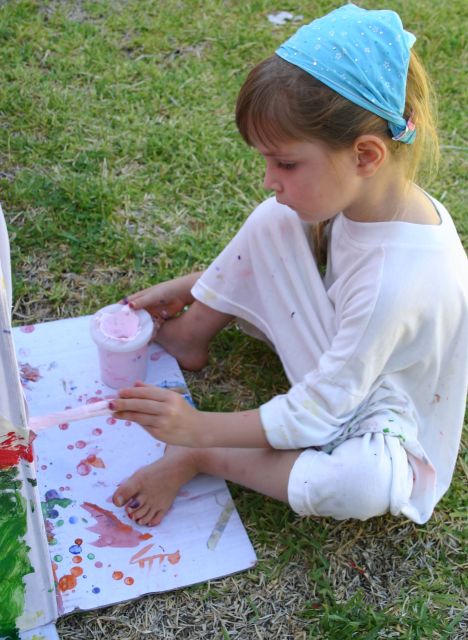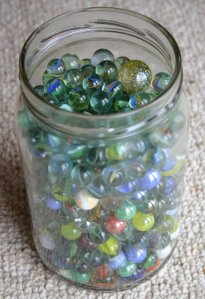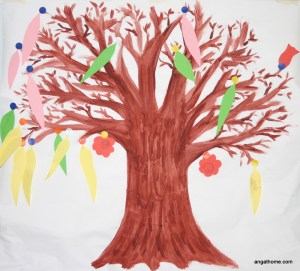
Unfortunately none of us have a fairy Godmother who is going to come along and make everything change with a swish of her magic wand.
In the parenting courses that we run, we discuss a concept called proactive parenting, as compared to reactive parenting. Reactive parents do exactly that – react to situations as they arise and parent in the heat of the moment. Proactive parents have a plan to get where they want to go and actively take steps to get there.
When I found my 11 month old sitting next to the art cupboard covered in yellow paint from head to toe I had a choice. Yell, moan about how difficult raising children is, decide that she was the last child we were ever going to have, remove all paint from our house and ban art forever, take her out in the back yard, dangle her by the big toe and hose her off to teach her a lesson (that was tempting!) or I could accept responsibility for the disaster and plan a proactive method to ensure this situation was not repeated. I chose to tweak my
flexible routine to ensure that she didn’t have unsupervised time to roam the house in the future.
In life, we all have the choice to live pro-actively or reactively – which way are you choosing?
When was the last time you sat down to honestly reflect on your life and evaluate what is going well and what needs work? Where are your sticky patches? Your areas of stress and difficulty? What are you trying to ignore, get around, push under the mat and otherwise refuse to deal with head on? What can you pat yourself on the back about and sit back to enjoy? What is getting up your nose and ruffling your feathers? What direction are you headed in and is this where you really want to go? Is it where God really wants you to go?
As areas of concern are identified, I write them down; with specifics. Exactly what or who is this problem about. Seeing it on paper helps me to realize that what I feel about a situation is not always accurate or relative to the problem. Sometimes the thing that is unhealthy is a lot smaller and simpler than my feelings would suggest. Sometimes it is a lot bigger and needs to be honestly acknowledged.
Now comes the hard part. Without a strong desire to change, even the best advice will be worthless. Without effort and commitment to improve, chances are you will still be facing the same problems in the future. Do you just want to talk about the problem? Do you just want sympathy? Or are you truly seeking a way to move forward and make the necessary changes? Some circumstances can’t be changed, but the way that you react and respond to them can. We can eliminate some of our problem areas, avert others or at least improve almost all of them.
Some changes take money. Some just take time, some take mental or physical effort. All change will take a decision by you to make it happen and an investment of some kind.
At the end of today’s post, there is a list of headings. You will probably be able to come up with several more of your own to add to it. I would encourage you over the coming week to take some time out to go through the list and give yourself a proactivity check. Identify the areas you would like to change and write them down. If you are like me, you will have a rather long list, which can be a little demoralizing. Perhaps you might like to focus on the most pressing issues. Have a look through your list and choose 3 things to begin with.

Do you have unrealised ambitions or goals? Always wanted to paint, sing, play an instrument, write a book?? Now’s the time to start.
It may be a good idea to focus on only one large, serious thing, and two smaller problems that will be quick and relatively easy to change. You can now make a plan and move forward.
So how do you move forward? You could do one or several of the following:
- Pray through each area and ask God for wisdom and direction. (Maybe the underlying issue is that your relationship with God is not where it should be. It is possible to make changes in your own strength, but so much more effective to make them with the help of the Holy Spirit. Perhaps now is the time to get right with God.)
- Read the bible and see what He already has to say about it.
- Find a Godly older, more mature or more experienced woman to serve as a mentor. (God’s idea, not mine; see Titus 2)
- Ask your husband for his ideas. I’m sure he has plenty! They might involve leopard-print, but hear him out anyway! Your husband has wisdom and insight that will help you to see issues in a different light.
- Find the resources you need. Buy or borrow a book, listen to a talk on CD, surf the net
- Find a friend or family member who is strong in the area of your weaknesses and ask for their help.
- Speak to a professional if necessary. Be it counselor, Pastor, financial planner, doctor, nutritionist etc.
Try to be realistic with your goal setting. One of my daughters was very disappointed to be told that she would never realize her ambition of growing up to be a Daddy! She quickly got over it though and decided she would be a snail instead!
When I see the heading “Physical health”, I immediately think of how I would like to bake fresh sour dough bread for our family. I have tried this once and the result was a brick-like loaf that would have made a better doorstop than a sandwich. Clearly, I need more than a recipe printed out from the internet. I am planning to take a 4 hour class with an expert on sour dough and come home equipped with the knowledge I need to achieve my goal. It requires some time, some money and the commitment to go ahead and get it organised.

- Perhaps a mess is driving you insane. Find a home organisation book, train your children to do chores and de-clutter!
When I look at the heading “Household” my linen cupboard comes to mind. Every time I opened the doors, towels and sheets exploded out at me from the over-filled bottom two shelves, while the top 2 shelves sat almost bare of their contents. My daughter is responsible for folding and putting away these items as they come through the wash. As she is only 7 ½ she finds it difficult to reach the top shelves, which results in the contents gradually migrating downwards. The solution? Two $8 sea grass storage baskets to store some of the towels in the other bathroom, re-arranging the cupboard so that the least used items were up the top and storing sheet sets in their matching pillowcases as a compact bundle (a tip from a home organisation book that I read.) While migration does still happen, it has been slowed greatly by the new arrangements.

The heading “Children and family” brings to mind a current issue we are facing. Our 3-year-old son quite often exits the toilet naked from the waist down, regardless of who is at the front door or how many visitors we have in the house. Modesty is something we work on as a family and as my husband and I want our children to be a blessing to others rather than a menace this is a problem we need to address and resolve – before he turns 16.
 Your problem areas may be far more serious than the examples I have given. Perhaps you are a single parent, divorced, facing addiction or abuse of some kind. Maybe you have lost 10 kgs and nothing in your wardrobe fits anymore. Perhaps you have gained 10 kg and nothing fits anymore. Maybe you need to get right with God. Whatever it is, it’s time to take action.
Your problem areas may be far more serious than the examples I have given. Perhaps you are a single parent, divorced, facing addiction or abuse of some kind. Maybe you have lost 10 kgs and nothing in your wardrobe fits anymore. Perhaps you have gained 10 kg and nothing fits anymore. Maybe you need to get right with God. Whatever it is, it’s time to take action.

What’s wrong with my clothes??
Now you may not be a Mother, or wife, but if you are a Christian, your general priorities should be: God first, husband second, children & family third and on from there.
Do not bury your head in the sand and hope your difficulties will go away. Face the problem head on and climb that mountain. We all have an obligation to use our God given talents to the best of our ability. Live intentionally and be proactive.
- Your diet will have an impact on your outlook, energy levels and overall health. Is change needed here?
Here are some headings to get you started on your pro-activity check:
Self-improvement (grooming and appearance, wardrobe, character, self-image, skills, talents, hobbies, interests, creativity, goals, aspirations, dreams, leadership)
Mental health (depression, stress, emotional problems, phobias, compulsions, suicidal feelings)
Physical health (diet & nutrition, exercise, weight control, sickness & pain)
Spiritual health (bible study, prayer life, relationship with God, spiritual gifts, teaching, evangelism, discipleship, proverbs 31 woman, Titus 2)
Social/relational (friendships, re-connect with someone, forgive someone, conversation & communication skills)
Marriage (husband/wife relationship, love languages, sex life, date nights, communication, marriage seminars, counseling)
Children and family (character, behaviour, relationships, discipline and training, routine)
Household (menu planning, hospitality, organization, home improvements, decorating, time management)
Work & study (time management, computer, facebook, emails)
Money (budgeting, giving, debt, saving)
| Issue |
Plan of attack – resources I need or action to take |
| 1. |
|
|
|
|
|
|
|
|
|
|
|
| 2. |
|
|
|
|
|
|
|
|
|
|
|
| 3. |
|
|
|
|
|
|
|
|
|
|
|
Filed under: Christian Education, character, Sundays and the Sabbath | Tagged: children & family, depression, goal setting, household improvements, mental health, planning, pro-active living, self-improvement | 2 Comments »



















































